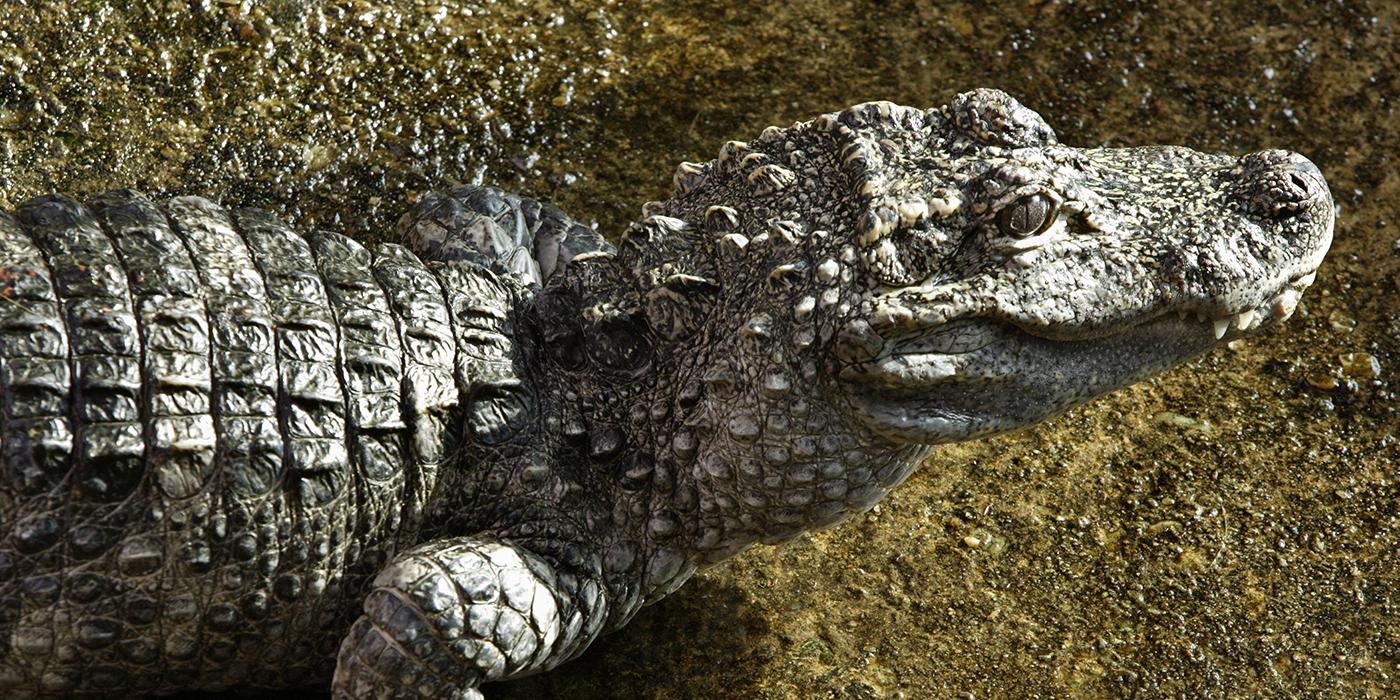Physical Description
The critically endangered Chinese alligator differs from its American counterpart in subtle ways. It's smaller, the head is more robust and its snout is slightly upturned. The eyelids of the Chinese alligator have a bony plate that is missing in the American alligator. The American alligator also lacks the bony belly plates, or osteoderms, of the Chinese alligator.
Size
Chinese alligators usually grow to about 5 feet (1.5 meters). The largest Chinese alligator measured in recent times was 7 feet and 1 inch--about half the size of the largest living American alligators. Some may weigh up to 85 pounds (38.5 kilograms); however, most weigh less than 50 pounds (23 kilograms).
Native Habitat
The Chinese alligator is the only member of the eight species in the Alligatoridae family to exist outside of the Americas. In historical times, the Chinese alligator was found in the extensive lakes and marshlands of the middle-lower Yangtze River region and along the river from Shanghai to Jianling City in the Hubei Province. Today it is limited to the lower Yangtze, primarily in the Anhui and Zhejiang provinces in eastern China.
Chinese alligators are found in slow-moving freshwater rivers and streams, including lakes, ponds and swamps. Marshlands, ponds, lakes, reservoirs, river backwater canals, rice paddies and irrigation networks provide suitable habitat.
Lifespan
Chinese alligators can live up to 70 years in human care. They can reproduce into their 50s.
Communication
Young vocalize to bring the group together and maintain its cohesion, while adults respond to juvenile distress calls. Bellowing occurs among males and females during the breeding season.
Food/Eating Habits
The Chinese alligator is an opportunistic feeder. Its diet mostly includes snails, crustaceans, insects and fish, but young waterfowl and rodents will be taken if available. Dentition includes blunt teeth adapted well to crushing shelled animals.
At the Smithsonian's National Zoo, Chinese alligators are fed small rats, mice and fish.
Sleep Habits
This species digs extensive earthen tunnels with multiple chambers, entrances and pools. Largely nocturnal because of human persecution, they stay in their tunnels much of the day when humans are in the vicinity as well as during cool weather and winter months.
Each year in April, the alligators emerge from their winter burrows and find sunny spots in which to bask. As summer begins, they switch to more nocturnal feeding habits to avoid the heat and humans while they begin their annual mating rituals.
Reproduction and Development
The mating system is polygamous, as a male may breed with more than one female. Both sexes may react very aggressively to one another, especially in first encounter situations. Social life begins before hatching, as nest mates communicate egg to egg and with parents who open the egg chamber when synchronized hatching begins. Nest mates may spend weeks to years together in the protection of the mother.
Females mature at about four to five years. Mating occurs in early summer, with the females building nests about two to three weeks later and laying up to four-dozen eggs; fewer than two-dozen is common. Hatchlings generally emerge in September. Females provide parental care, including assisting the hatching process and carrying the newly hatched young from the nests, which are located on land, to the water.
Conservation Efforts
The Chinese alligator is in desperate need of habitat conservation and protection in the wild. The wild population may be fewer than 150 individuals. About 100 Chinese alligators are managed under the Species Survival Program in North American institutions.
Help this Species
Share the story of this animal with others. Simply raising awareness about this species can contribute to its overall protection.
Smithsonian's National Zoo and Conservation Biology Institute. (n.d.). Chinese alligator. Retrieved December 5, 2025, from https://nationalzoo.si.edu/animals/chinese-alligator
Animal News
Applications Open for Behind-the-Scenes Volunteer Support ›

Giant Panda Qing Bao Gets a Checkup ›



